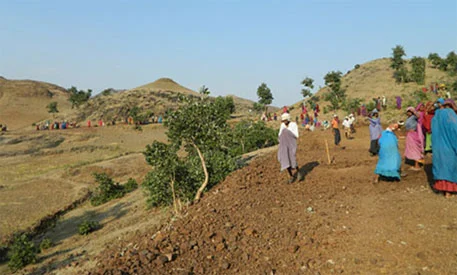Workers Struggle to Make Ends Meet as Minimum Wage Rates Lag Behind Inflation
NEW DELHI- Despite being India’s flagship employment scheme, the Mahatma Gandhi National Rural Employment Guarantee Act (MNREGA) faces scrutiny over sluggish wage growth, exacerbating the financial woes of unskilled laborers across the country.
Since 2018-19, the average wage rate for unskilled manual workers under MNREGA has seen a lethargic increase, rising from ₹207 to ₹259 in 2023-24. However, with an average annual growth rate of merely 4.5 percent during this period, critics argue that this uptick fails to keep pace with the escalating cost of living, especially amid soaring inflation rates.
According to media reports, the current wage rates have proven insufficient to meet the basic needs of workers, fueling concerns about deteriorating living standards. Even in comparison to rising inflation, the incremental wage hikes have struggled to alleviate financial burdens, leaving many workers struggling to make ends meet.
While there was a notable increase of 8.71 percent in the MNREGA wage rate during the pandemic-induced migration in 2020-21, subsequent raises have been minimal. In 2022-23, the wage rate saw a mere 1.55 percent increase, further highlighting the challenge of sustaining livelihoods amidst economic uncertainties.
The objective of MNREGA is to provide 100 days of guaranteed employment to unskilled manual laborers in each rural household. However, the removal of minimum wage guarantees from MNREGA wages in 2009 has impeded the rate of wage growth, exacerbating financial hardships for workers.
Despite substantial government spending on MNREGA, with a revised allocation of ₹1.08 lakh crore for key schemes in 2023-24, challenges persist in ensuring equitable wage rates across states. Disparities in wage rates between states, as highlighted by reports from The Hindu Businessline and Mazdoor Unity, underscore the need for uniformity to address inequality.
However, while some advocate for standardized wage rates, others like social activist Nikhil Dey argue for contextualized approaches, considering regional variations in living standards and aspirations.
Additionally, declining demand for employment under MNREGA raises concerns about the scheme’s efficacy in providing consistent work opportunities. Factors such as irregular work schedules and delays in wage payments contribute to diminishing interest in the program among potential beneficiaries.
In states like Madhya Pradesh, delays in wage disbursements have left over 2 lakh MNREGA workers without payment for several months, exacerbating their financial distress. The issue has garnered attention from national figures like Congress Party’s Priyanka Gandhi Vadra, who have criticized the government’s handling of the scheme.
Moreover, recent changes, such as the shift to Aadhaar-based payments, have faced backlash for causing disruptions in wage distribution and potentially excluding vulnerable workers without bank accounts. Critics argue that such measures undermine the scheme’s core objective of alleviating poverty and empowering rural communities.
As the government grapples with addressing these challenges, the future of MNREGA remains uncertain. While it has been instrumental in providing employment opportunities for millions, ensuring its effectiveness amidst evolving economic landscapes remains a pressing concern for policymakers and stakeholders alike.

